Kaplan Business School MBA501: Facebook Stakeholder Analysis Report
VerifiedAdded on 2022/10/18
|12
|2295
|259
Report
AI Summary
This report presents a comprehensive stakeholder analysis of Facebook, examining its key stakeholders, including users, marketers, competitors, and top management executives. The report begins with an introduction to Facebook, outlining its vision, mission, and recent developments. It then utilizes a stakeholder view model to identify and categorize various stakeholder groups. A detailed analysis is provided for four selected stakeholder groups: Facebook users, marketers, competitors, and top management. For each group, the analysis covers behavioral patterns, motives, and potential coalitions. The report highlights the importance of understanding stakeholder dynamics for Facebook's strategic planning and overall success, discussing the interplay between different stakeholder groups and their impact on the company's operations and objectives. The report concludes by summarizing the key findings and emphasizing the significance of stakeholder management in the context of Facebook's business environment.
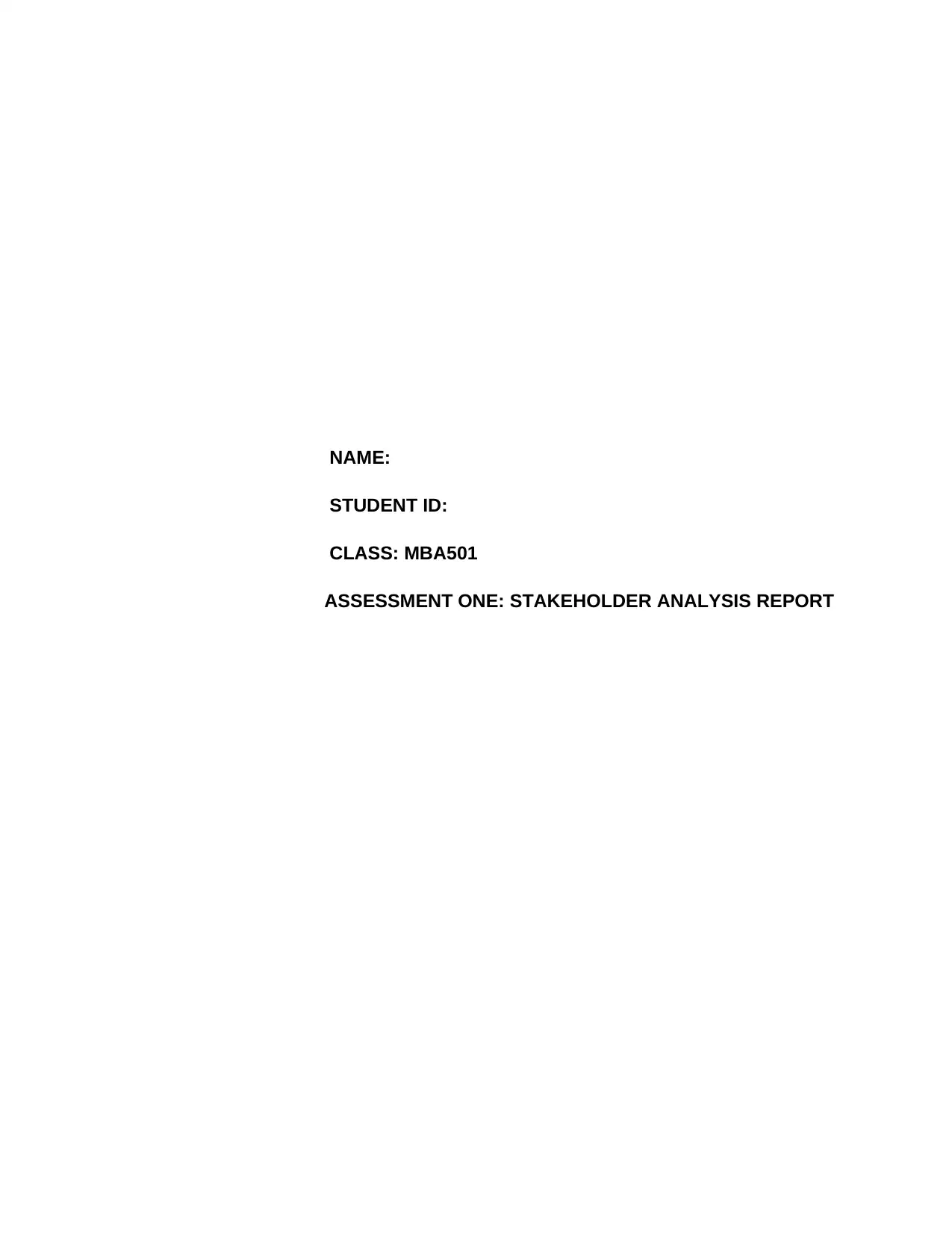
NAME:
STUDENT ID:
CLASS: MBA501
ASSESSMENT ONE: STAKEHOLDER ANALYSIS REPORT
STUDENT ID:
CLASS: MBA501
ASSESSMENT ONE: STAKEHOLDER ANALYSIS REPORT
Paraphrase This Document
Need a fresh take? Get an instant paraphrase of this document with our AI Paraphraser
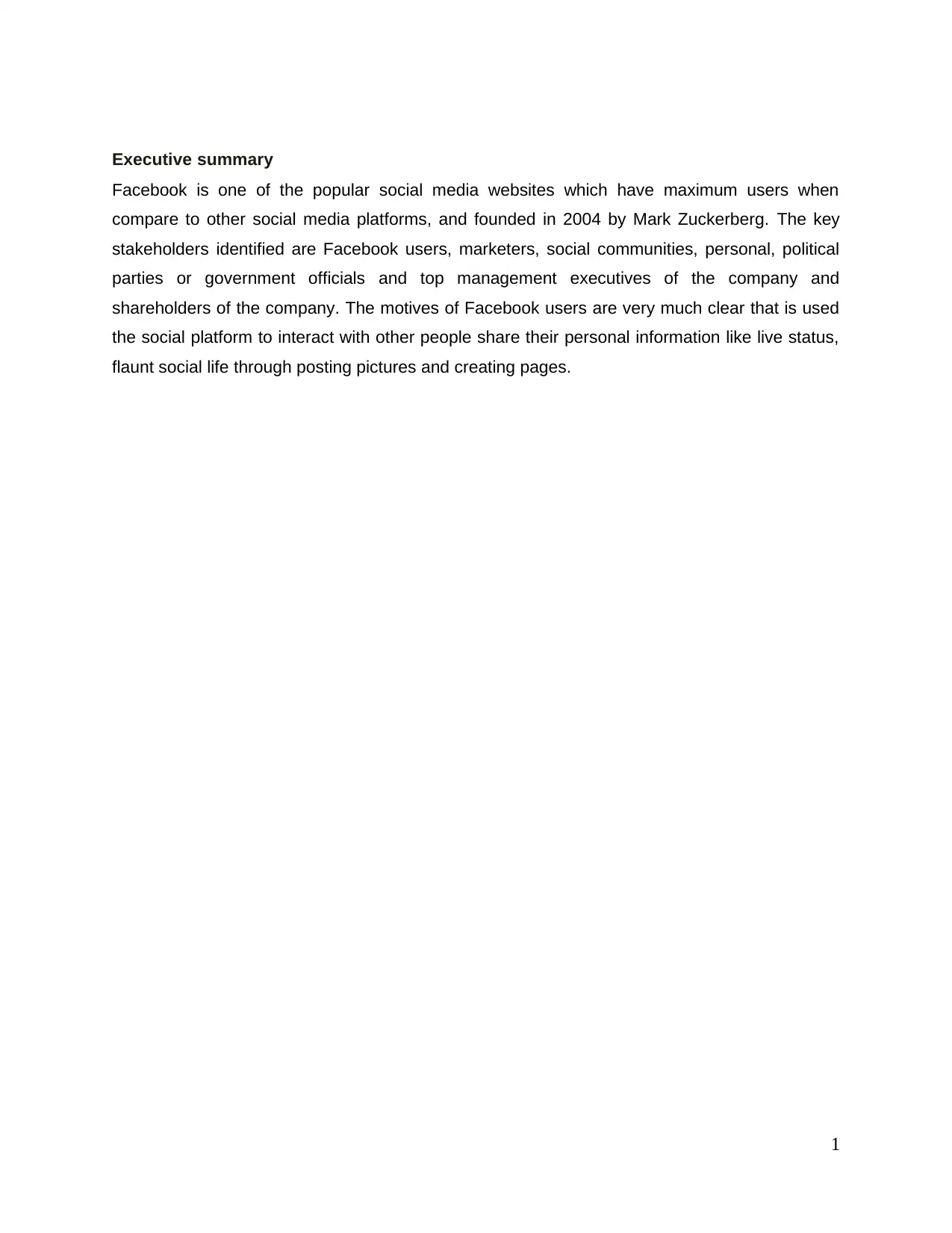
Executive summary
Facebook is one of the popular social media websites which have maximum users when
compare to other social media platforms, and founded in 2004 by Mark Zuckerberg. The key
stakeholders identified are Facebook users, marketers, social communities, personal, political
parties or government officials and top management executives of the company and
shareholders of the company. The motives of Facebook users are very much clear that is used
the social platform to interact with other people share their personal information like live status,
flaunt social life through posting pictures and creating pages.
1
Facebook is one of the popular social media websites which have maximum users when
compare to other social media platforms, and founded in 2004 by Mark Zuckerberg. The key
stakeholders identified are Facebook users, marketers, social communities, personal, political
parties or government officials and top management executives of the company and
shareholders of the company. The motives of Facebook users are very much clear that is used
the social platform to interact with other people share their personal information like live status,
flaunt social life through posting pictures and creating pages.
1
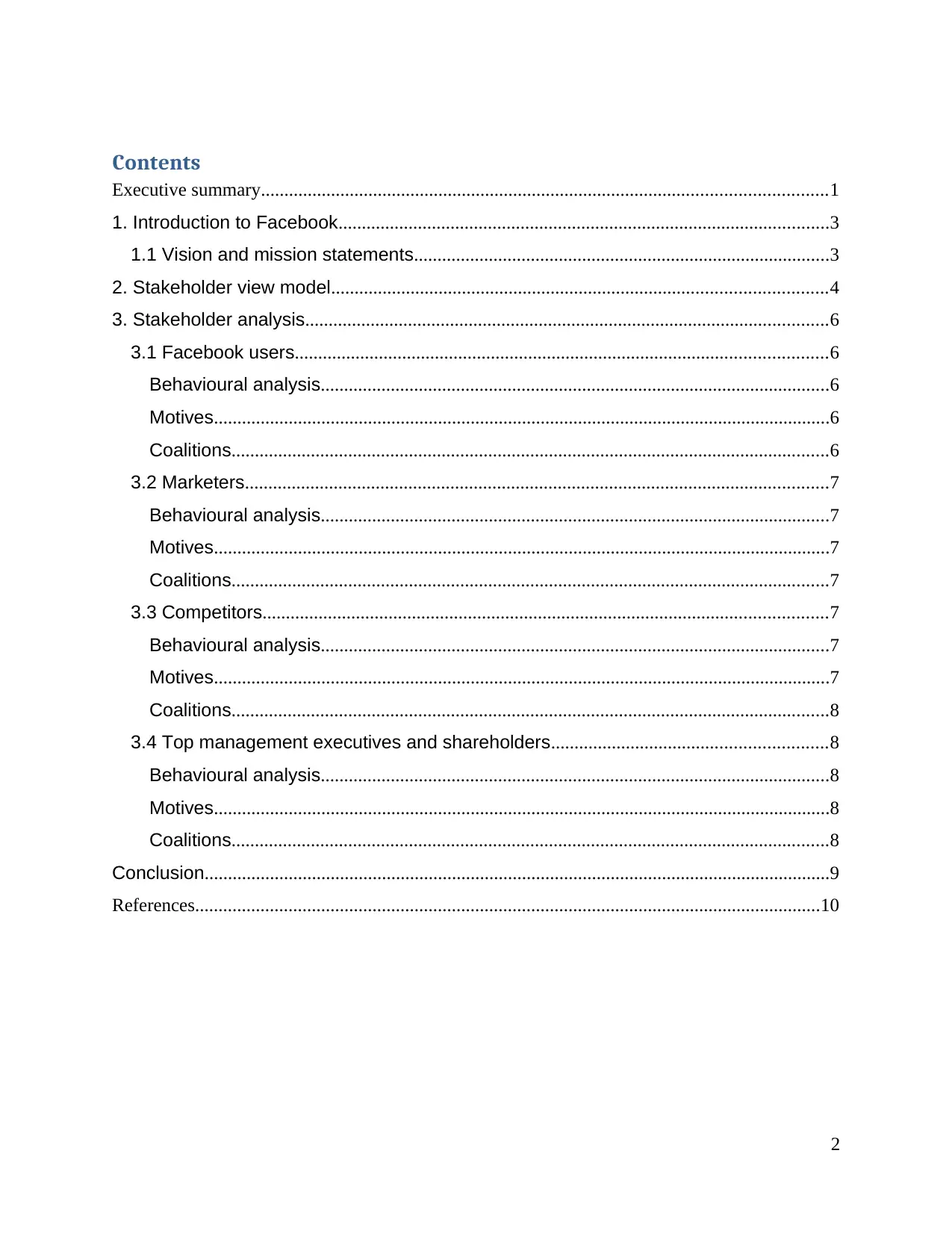
Contents
Executive summary.........................................................................................................................1
1. Introduction to Facebook.........................................................................................................3
1.1 Vision and mission statements.........................................................................................3
2. Stakeholder view model..........................................................................................................4
3. Stakeholder analysis................................................................................................................6
3.1 Facebook users..................................................................................................................6
Behavioural analysis.............................................................................................................6
Motives....................................................................................................................................6
Coalitions................................................................................................................................6
3.2 Marketers.............................................................................................................................7
Behavioural analysis.............................................................................................................7
Motives....................................................................................................................................7
Coalitions................................................................................................................................7
3.3 Competitors.........................................................................................................................7
Behavioural analysis.............................................................................................................7
Motives....................................................................................................................................7
Coalitions................................................................................................................................8
3.4 Top management executives and shareholders...........................................................8
Behavioural analysis.............................................................................................................8
Motives....................................................................................................................................8
Coalitions................................................................................................................................8
Conclusion......................................................................................................................................9
References......................................................................................................................................10
2
Executive summary.........................................................................................................................1
1. Introduction to Facebook.........................................................................................................3
1.1 Vision and mission statements.........................................................................................3
2. Stakeholder view model..........................................................................................................4
3. Stakeholder analysis................................................................................................................6
3.1 Facebook users..................................................................................................................6
Behavioural analysis.............................................................................................................6
Motives....................................................................................................................................6
Coalitions................................................................................................................................6
3.2 Marketers.............................................................................................................................7
Behavioural analysis.............................................................................................................7
Motives....................................................................................................................................7
Coalitions................................................................................................................................7
3.3 Competitors.........................................................................................................................7
Behavioural analysis.............................................................................................................7
Motives....................................................................................................................................7
Coalitions................................................................................................................................8
3.4 Top management executives and shareholders...........................................................8
Behavioural analysis.............................................................................................................8
Motives....................................................................................................................................8
Coalitions................................................................................................................................8
Conclusion......................................................................................................................................9
References......................................................................................................................................10
2
⊘ This is a preview!⊘
Do you want full access?
Subscribe today to unlock all pages.

Trusted by 1+ million students worldwide
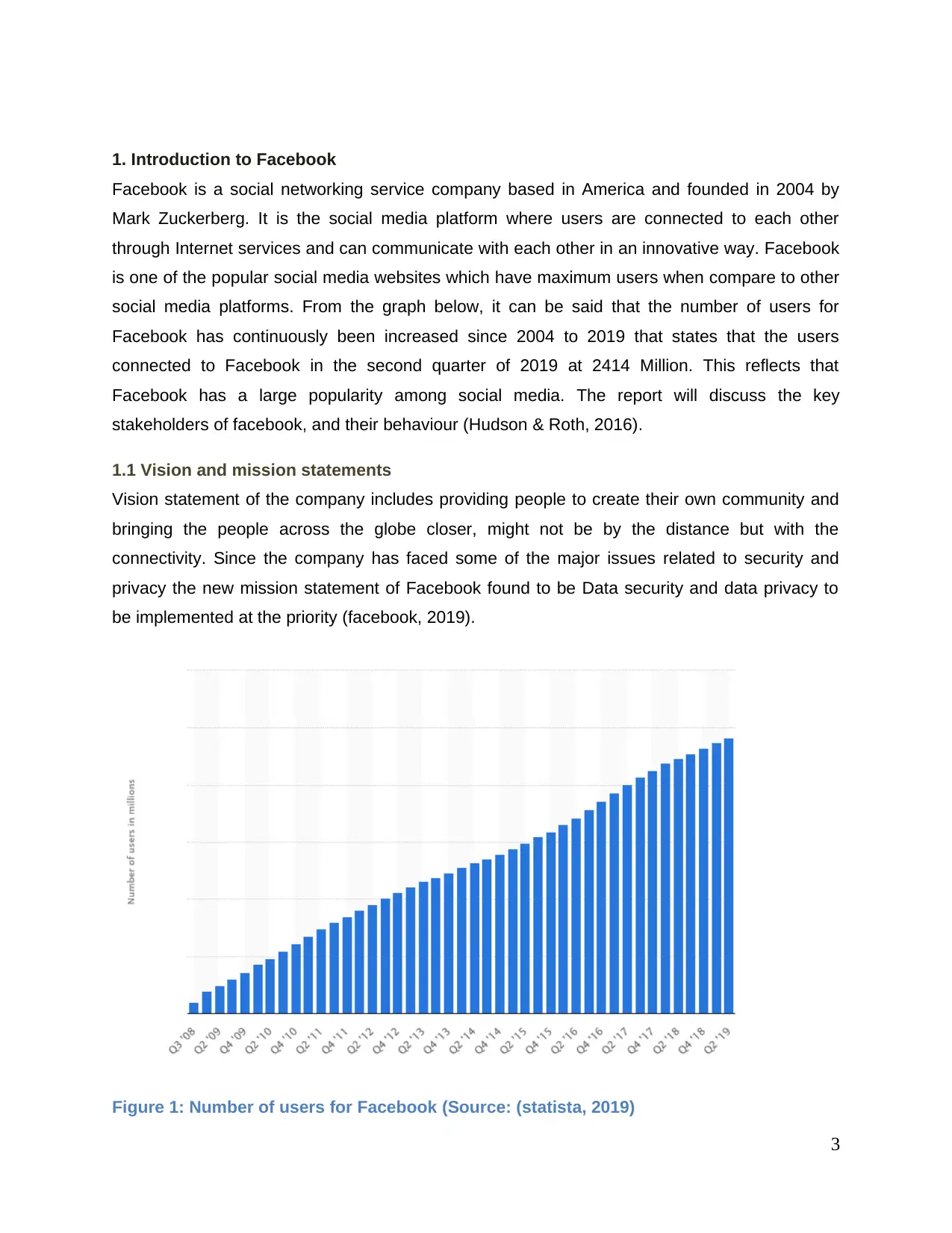
1. Introduction to Facebook
Facebook is a social networking service company based in America and founded in 2004 by
Mark Zuckerberg. It is the social media platform where users are connected to each other
through Internet services and can communicate with each other in an innovative way. Facebook
is one of the popular social media websites which have maximum users when compare to other
social media platforms. From the graph below, it can be said that the number of users for
Facebook has continuously been increased since 2004 to 2019 that states that the users
connected to Facebook in the second quarter of 2019 at 2414 Million. This reflects that
Facebook has a large popularity among social media. The report will discuss the key
stakeholders of facebook, and their behaviour (Hudson & Roth, 2016).
1.1 Vision and mission statements
Vision statement of the company includes providing people to create their own community and
bringing the people across the globe closer, might not be by the distance but with the
connectivity. Since the company has faced some of the major issues related to security and
privacy the new mission statement of Facebook found to be Data security and data privacy to
be implemented at the priority (facebook, 2019).
Figure 1: Number of users for Facebook (Source: (statista, 2019)
3
Facebook is a social networking service company based in America and founded in 2004 by
Mark Zuckerberg. It is the social media platform where users are connected to each other
through Internet services and can communicate with each other in an innovative way. Facebook
is one of the popular social media websites which have maximum users when compare to other
social media platforms. From the graph below, it can be said that the number of users for
Facebook has continuously been increased since 2004 to 2019 that states that the users
connected to Facebook in the second quarter of 2019 at 2414 Million. This reflects that
Facebook has a large popularity among social media. The report will discuss the key
stakeholders of facebook, and their behaviour (Hudson & Roth, 2016).
1.1 Vision and mission statements
Vision statement of the company includes providing people to create their own community and
bringing the people across the globe closer, might not be by the distance but with the
connectivity. Since the company has faced some of the major issues related to security and
privacy the new mission statement of Facebook found to be Data security and data privacy to
be implemented at the priority (facebook, 2019).
Figure 1: Number of users for Facebook (Source: (statista, 2019)
3
Paraphrase This Document
Need a fresh take? Get an instant paraphrase of this document with our AI Paraphraser
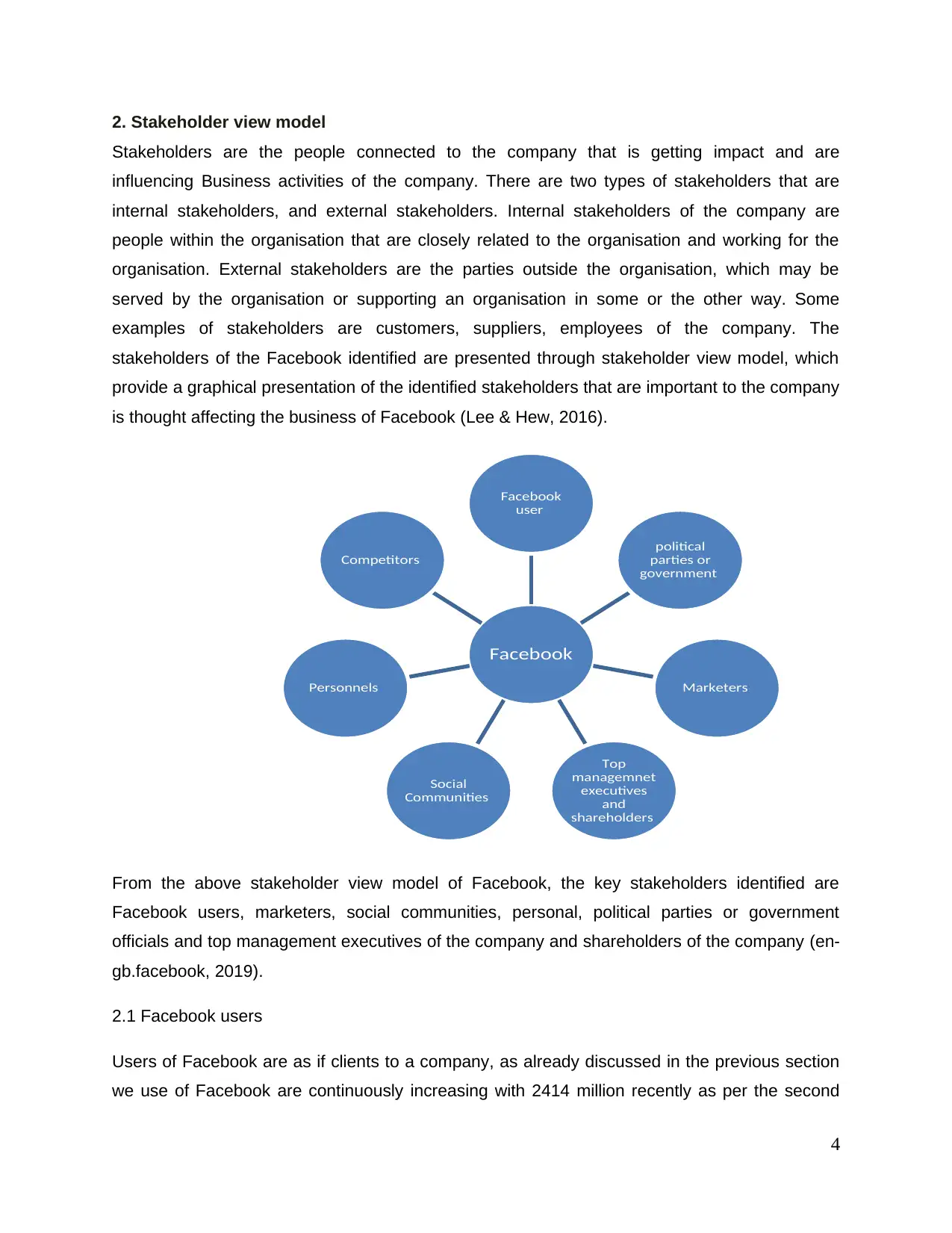
2. Stakeholder view model
Stakeholders are the people connected to the company that is getting impact and are
influencing Business activities of the company. There are two types of stakeholders that are
internal stakeholders, and external stakeholders. Internal stakeholders of the company are
people within the organisation that are closely related to the organisation and working for the
organisation. External stakeholders are the parties outside the organisation, which may be
served by the organisation or supporting an organisation in some or the other way. Some
examples of stakeholders are customers, suppliers, employees of the company. The
stakeholders of the Facebook identified are presented through stakeholder view model, which
provide a graphical presentation of the identified stakeholders that are important to the company
is thought affecting the business of Facebook (Lee & Hew, 2016).
From the above stakeholder view model of Facebook, the key stakeholders identified are
Facebook users, marketers, social communities, personal, political parties or government
officials and top management executives of the company and shareholders of the company (en-
gb.facebook, 2019).
2.1 Facebook users
Users of Facebook are as if clients to a company, as already discussed in the previous section
we use of Facebook are continuously increasing with 2414 million recently as per the second
4
Facebook
Facebook
user
political
parties or
government
Marketers
Top
managemnet
executives
and
shareholders
Social
Communities
Personnels
Competitors
Stakeholders are the people connected to the company that is getting impact and are
influencing Business activities of the company. There are two types of stakeholders that are
internal stakeholders, and external stakeholders. Internal stakeholders of the company are
people within the organisation that are closely related to the organisation and working for the
organisation. External stakeholders are the parties outside the organisation, which may be
served by the organisation or supporting an organisation in some or the other way. Some
examples of stakeholders are customers, suppliers, employees of the company. The
stakeholders of the Facebook identified are presented through stakeholder view model, which
provide a graphical presentation of the identified stakeholders that are important to the company
is thought affecting the business of Facebook (Lee & Hew, 2016).
From the above stakeholder view model of Facebook, the key stakeholders identified are
Facebook users, marketers, social communities, personal, political parties or government
officials and top management executives of the company and shareholders of the company (en-
gb.facebook, 2019).
2.1 Facebook users
Users of Facebook are as if clients to a company, as already discussed in the previous section
we use of Facebook are continuously increasing with 2414 million recently as per the second
4
user
political
parties or
government
Marketers
Top
managemnet
executives
and
shareholders
Social
Communities
Personnels
Competitors
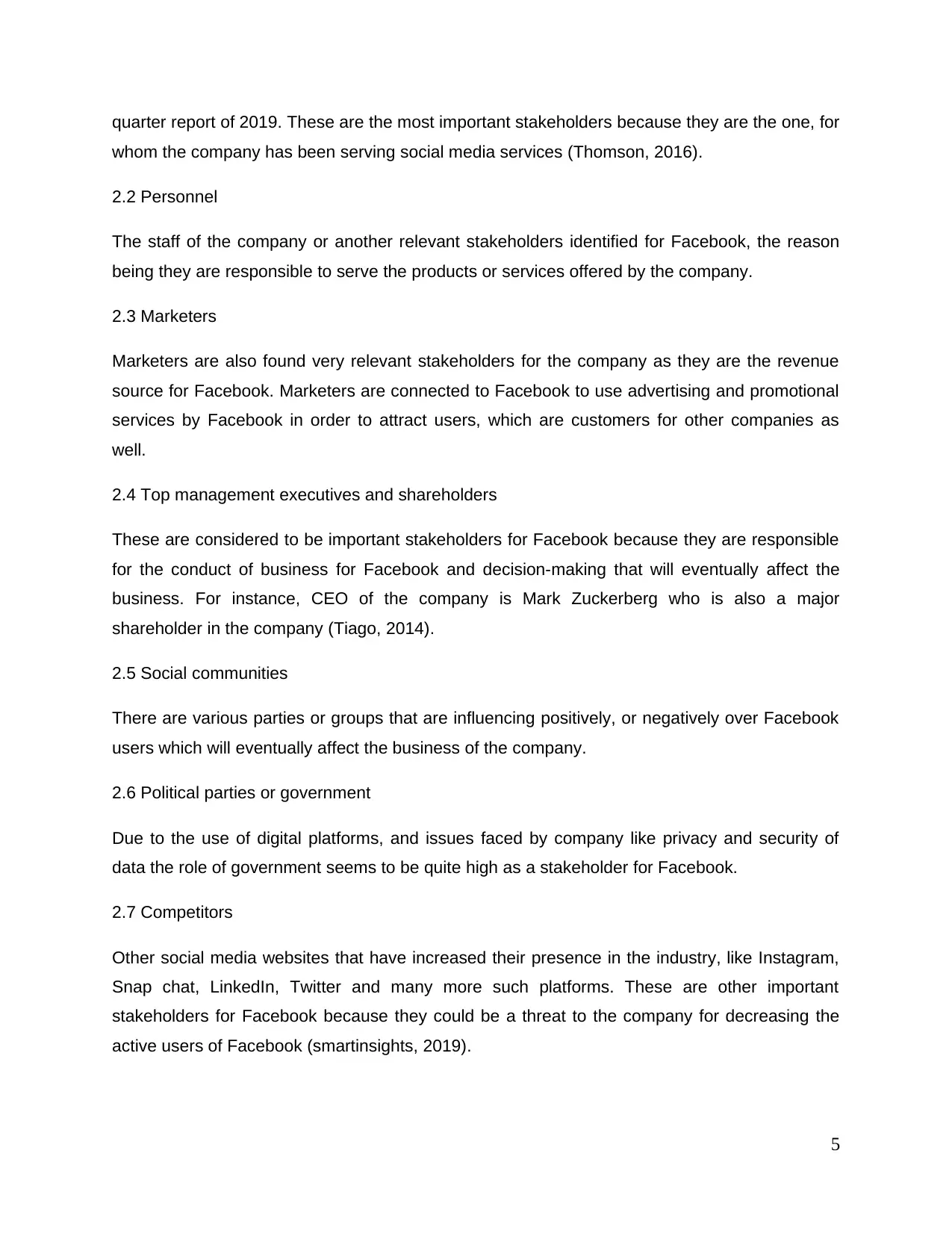
quarter report of 2019. These are the most important stakeholders because they are the one, for
whom the company has been serving social media services (Thomson, 2016).
2.2 Personnel
The staff of the company or another relevant stakeholders identified for Facebook, the reason
being they are responsible to serve the products or services offered by the company.
2.3 Marketers
Marketers are also found very relevant stakeholders for the company as they are the revenue
source for Facebook. Marketers are connected to Facebook to use advertising and promotional
services by Facebook in order to attract users, which are customers for other companies as
well.
2.4 Top management executives and shareholders
These are considered to be important stakeholders for Facebook because they are responsible
for the conduct of business for Facebook and decision-making that will eventually affect the
business. For instance, CEO of the company is Mark Zuckerberg who is also a major
shareholder in the company (Tiago, 2014).
2.5 Social communities
There are various parties or groups that are influencing positively, or negatively over Facebook
users which will eventually affect the business of the company.
2.6 Political parties or government
Due to the use of digital platforms, and issues faced by company like privacy and security of
data the role of government seems to be quite high as a stakeholder for Facebook.
2.7 Competitors
Other social media websites that have increased their presence in the industry, like Instagram,
Snap chat, LinkedIn, Twitter and many more such platforms. These are other important
stakeholders for Facebook because they could be a threat to the company for decreasing the
active users of Facebook (smartinsights, 2019).
5
whom the company has been serving social media services (Thomson, 2016).
2.2 Personnel
The staff of the company or another relevant stakeholders identified for Facebook, the reason
being they are responsible to serve the products or services offered by the company.
2.3 Marketers
Marketers are also found very relevant stakeholders for the company as they are the revenue
source for Facebook. Marketers are connected to Facebook to use advertising and promotional
services by Facebook in order to attract users, which are customers for other companies as
well.
2.4 Top management executives and shareholders
These are considered to be important stakeholders for Facebook because they are responsible
for the conduct of business for Facebook and decision-making that will eventually affect the
business. For instance, CEO of the company is Mark Zuckerberg who is also a major
shareholder in the company (Tiago, 2014).
2.5 Social communities
There are various parties or groups that are influencing positively, or negatively over Facebook
users which will eventually affect the business of the company.
2.6 Political parties or government
Due to the use of digital platforms, and issues faced by company like privacy and security of
data the role of government seems to be quite high as a stakeholder for Facebook.
2.7 Competitors
Other social media websites that have increased their presence in the industry, like Instagram,
Snap chat, LinkedIn, Twitter and many more such platforms. These are other important
stakeholders for Facebook because they could be a threat to the company for decreasing the
active users of Facebook (smartinsights, 2019).
5
⊘ This is a preview!⊘
Do you want full access?
Subscribe today to unlock all pages.

Trusted by 1+ million students worldwide
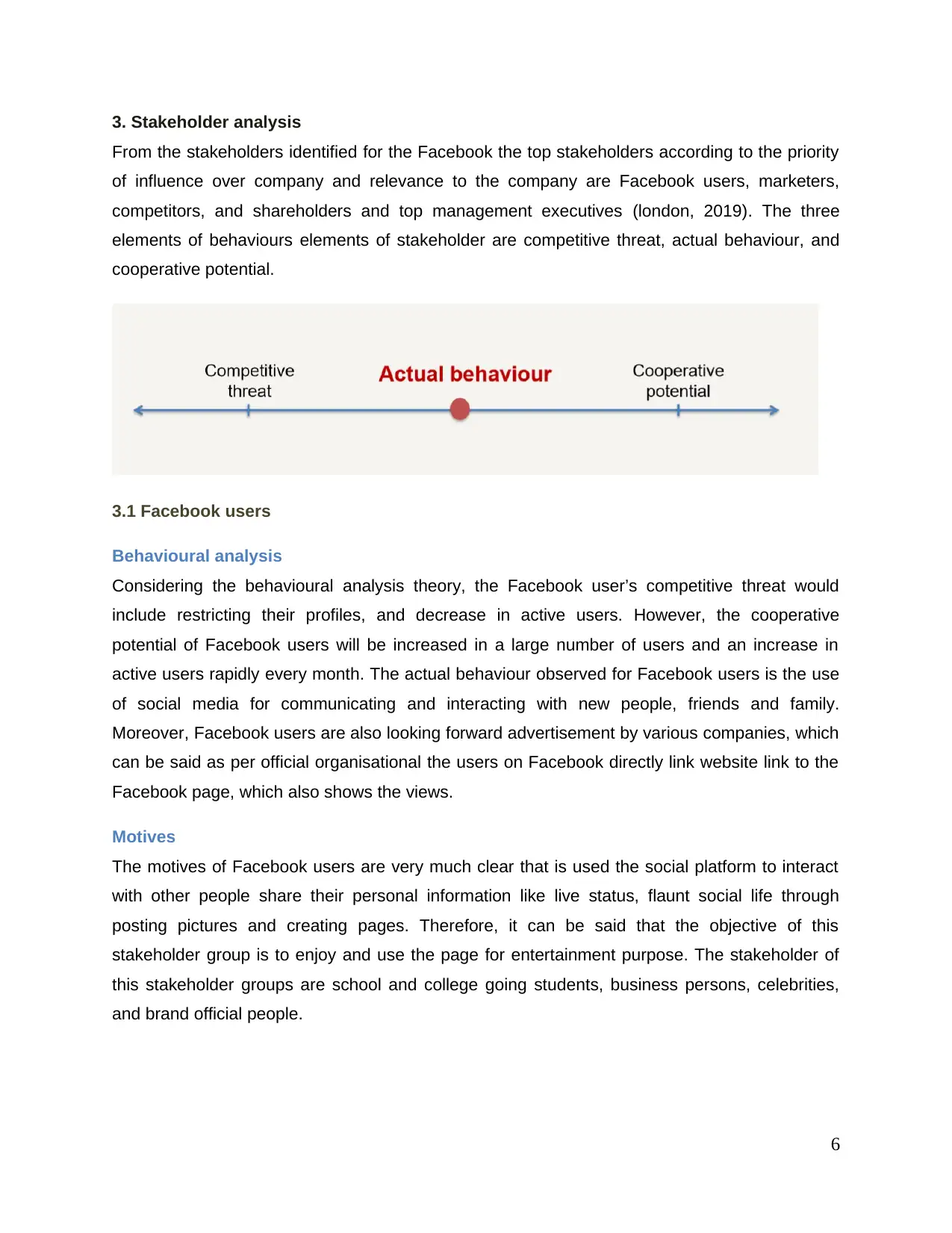
3. Stakeholder analysis
From the stakeholders identified for the Facebook the top stakeholders according to the priority
of influence over company and relevance to the company are Facebook users, marketers,
competitors, and shareholders and top management executives (london, 2019). The three
elements of behaviours elements of stakeholder are competitive threat, actual behaviour, and
cooperative potential.
3.1 Facebook users
Behavioural analysis
Considering the behavioural analysis theory, the Facebook user’s competitive threat would
include restricting their profiles, and decrease in active users. However, the cooperative
potential of Facebook users will be increased in a large number of users and an increase in
active users rapidly every month. The actual behaviour observed for Facebook users is the use
of social media for communicating and interacting with new people, friends and family.
Moreover, Facebook users are also looking forward advertisement by various companies, which
can be said as per official organisational the users on Facebook directly link website link to the
Facebook page, which also shows the views.
Motives
The motives of Facebook users are very much clear that is used the social platform to interact
with other people share their personal information like live status, flaunt social life through
posting pictures and creating pages. Therefore, it can be said that the objective of this
stakeholder group is to enjoy and use the page for entertainment purpose. The stakeholder of
this stakeholder groups are school and college going students, business persons, celebrities,
and brand official people.
6
From the stakeholders identified for the Facebook the top stakeholders according to the priority
of influence over company and relevance to the company are Facebook users, marketers,
competitors, and shareholders and top management executives (london, 2019). The three
elements of behaviours elements of stakeholder are competitive threat, actual behaviour, and
cooperative potential.
3.1 Facebook users
Behavioural analysis
Considering the behavioural analysis theory, the Facebook user’s competitive threat would
include restricting their profiles, and decrease in active users. However, the cooperative
potential of Facebook users will be increased in a large number of users and an increase in
active users rapidly every month. The actual behaviour observed for Facebook users is the use
of social media for communicating and interacting with new people, friends and family.
Moreover, Facebook users are also looking forward advertisement by various companies, which
can be said as per official organisational the users on Facebook directly link website link to the
Facebook page, which also shows the views.
Motives
The motives of Facebook users are very much clear that is used the social platform to interact
with other people share their personal information like live status, flaunt social life through
posting pictures and creating pages. Therefore, it can be said that the objective of this
stakeholder group is to enjoy and use the page for entertainment purpose. The stakeholder of
this stakeholder groups are school and college going students, business persons, celebrities,
and brand official people.
6
Paraphrase This Document
Need a fresh take? Get an instant paraphrase of this document with our AI Paraphraser
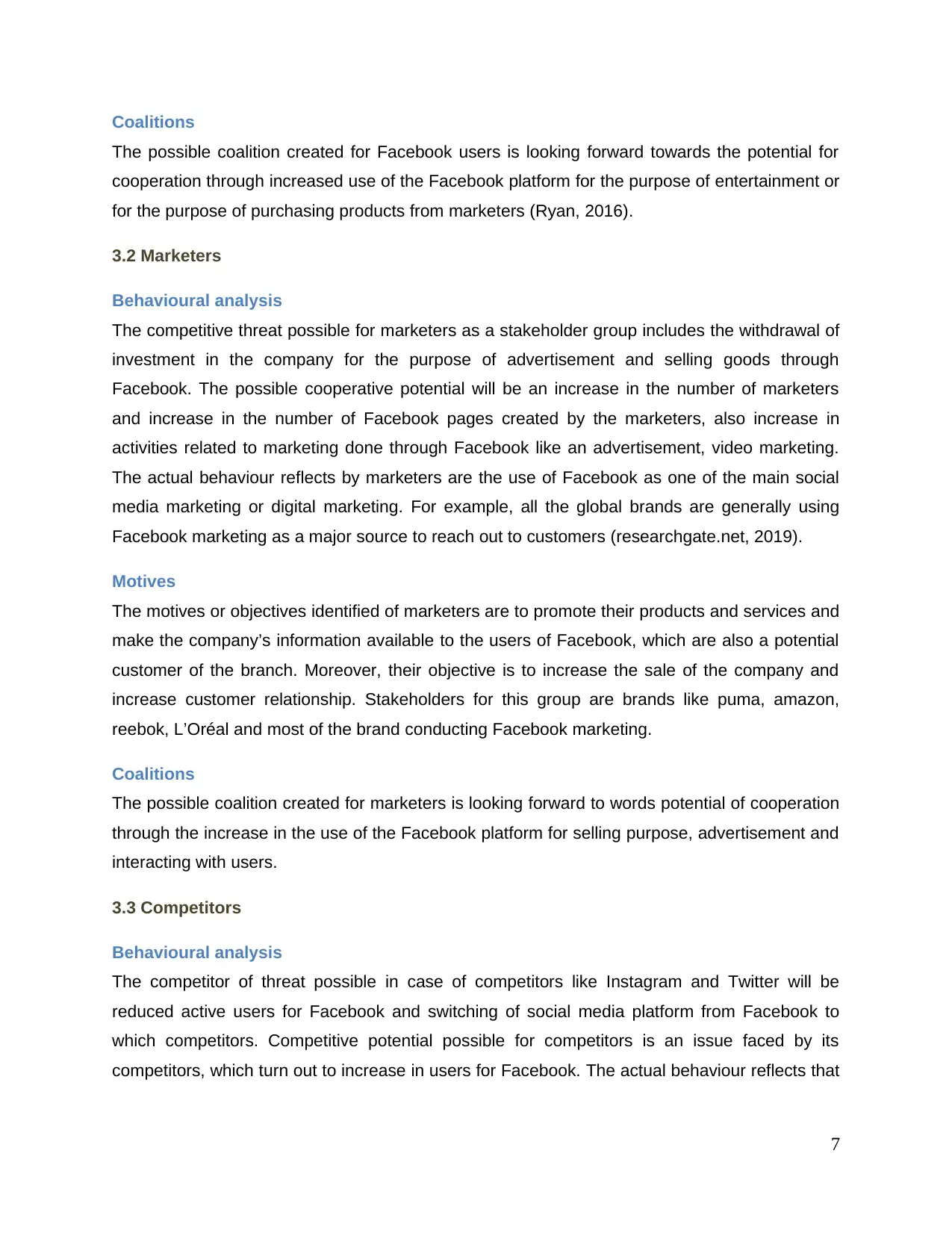
Coalitions
The possible coalition created for Facebook users is looking forward towards the potential for
cooperation through increased use of the Facebook platform for the purpose of entertainment or
for the purpose of purchasing products from marketers (Ryan, 2016).
3.2 Marketers
Behavioural analysis
The competitive threat possible for marketers as a stakeholder group includes the withdrawal of
investment in the company for the purpose of advertisement and selling goods through
Facebook. The possible cooperative potential will be an increase in the number of marketers
and increase in the number of Facebook pages created by the marketers, also increase in
activities related to marketing done through Facebook like an advertisement, video marketing.
The actual behaviour reflects by marketers are the use of Facebook as one of the main social
media marketing or digital marketing. For example, all the global brands are generally using
Facebook marketing as a major source to reach out to customers (researchgate.net, 2019).
Motives
The motives or objectives identified of marketers are to promote their products and services and
make the company’s information available to the users of Facebook, which are also a potential
customer of the branch. Moreover, their objective is to increase the sale of the company and
increase customer relationship. Stakeholders for this group are brands like puma, amazon,
reebok, L’Oréal and most of the brand conducting Facebook marketing.
Coalitions
The possible coalition created for marketers is looking forward to words potential of cooperation
through the increase in the use of the Facebook platform for selling purpose, advertisement and
interacting with users.
3.3 Competitors
Behavioural analysis
The competitor of threat possible in case of competitors like Instagram and Twitter will be
reduced active users for Facebook and switching of social media platform from Facebook to
which competitors. Competitive potential possible for competitors is an issue faced by its
competitors, which turn out to increase in users for Facebook. The actual behaviour reflects that
7
The possible coalition created for Facebook users is looking forward towards the potential for
cooperation through increased use of the Facebook platform for the purpose of entertainment or
for the purpose of purchasing products from marketers (Ryan, 2016).
3.2 Marketers
Behavioural analysis
The competitive threat possible for marketers as a stakeholder group includes the withdrawal of
investment in the company for the purpose of advertisement and selling goods through
Facebook. The possible cooperative potential will be an increase in the number of marketers
and increase in the number of Facebook pages created by the marketers, also increase in
activities related to marketing done through Facebook like an advertisement, video marketing.
The actual behaviour reflects by marketers are the use of Facebook as one of the main social
media marketing or digital marketing. For example, all the global brands are generally using
Facebook marketing as a major source to reach out to customers (researchgate.net, 2019).
Motives
The motives or objectives identified of marketers are to promote their products and services and
make the company’s information available to the users of Facebook, which are also a potential
customer of the branch. Moreover, their objective is to increase the sale of the company and
increase customer relationship. Stakeholders for this group are brands like puma, amazon,
reebok, L’Oréal and most of the brand conducting Facebook marketing.
Coalitions
The possible coalition created for marketers is looking forward to words potential of cooperation
through the increase in the use of the Facebook platform for selling purpose, advertisement and
interacting with users.
3.3 Competitors
Behavioural analysis
The competitor of threat possible in case of competitors like Instagram and Twitter will be
reduced active users for Facebook and switching of social media platform from Facebook to
which competitors. Competitive potential possible for competitors is an issue faced by its
competitors, which turn out to increase in users for Facebook. The actual behaviour reflects that
7
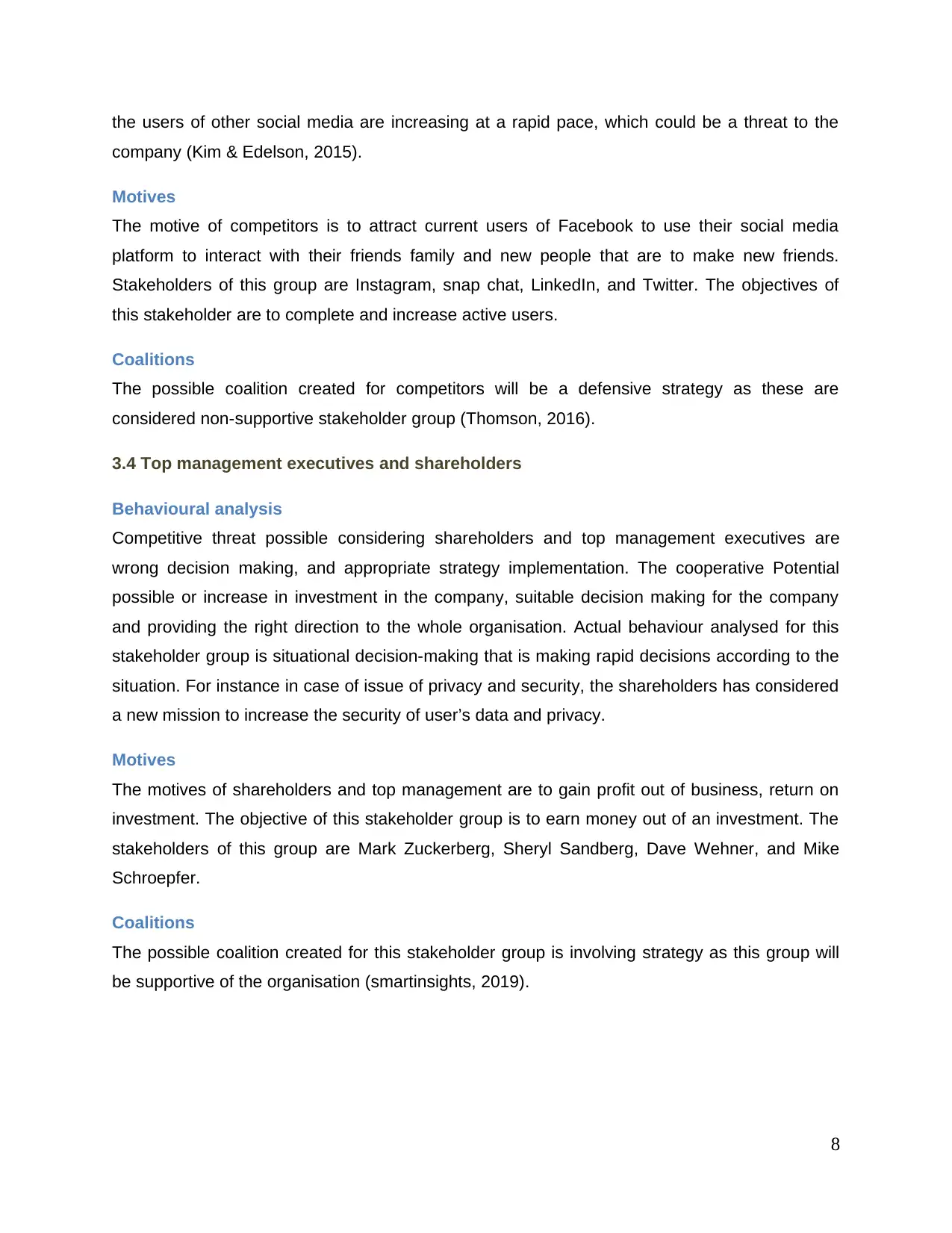
the users of other social media are increasing at a rapid pace, which could be a threat to the
company (Kim & Edelson, 2015).
Motives
The motive of competitors is to attract current users of Facebook to use their social media
platform to interact with their friends family and new people that are to make new friends.
Stakeholders of this group are Instagram, snap chat, LinkedIn, and Twitter. The objectives of
this stakeholder are to complete and increase active users.
Coalitions
The possible coalition created for competitors will be a defensive strategy as these are
considered non-supportive stakeholder group (Thomson, 2016).
3.4 Top management executives and shareholders
Behavioural analysis
Competitive threat possible considering shareholders and top management executives are
wrong decision making, and appropriate strategy implementation. The cooperative Potential
possible or increase in investment in the company, suitable decision making for the company
and providing the right direction to the whole organisation. Actual behaviour analysed for this
stakeholder group is situational decision-making that is making rapid decisions according to the
situation. For instance in case of issue of privacy and security, the shareholders has considered
a new mission to increase the security of user’s data and privacy.
Motives
The motives of shareholders and top management are to gain profit out of business, return on
investment. The objective of this stakeholder group is to earn money out of an investment. The
stakeholders of this group are Mark Zuckerberg, Sheryl Sandberg, Dave Wehner, and Mike
Schroepfer.
Coalitions
The possible coalition created for this stakeholder group is involving strategy as this group will
be supportive of the organisation (smartinsights, 2019).
8
company (Kim & Edelson, 2015).
Motives
The motive of competitors is to attract current users of Facebook to use their social media
platform to interact with their friends family and new people that are to make new friends.
Stakeholders of this group are Instagram, snap chat, LinkedIn, and Twitter. The objectives of
this stakeholder are to complete and increase active users.
Coalitions
The possible coalition created for competitors will be a defensive strategy as these are
considered non-supportive stakeholder group (Thomson, 2016).
3.4 Top management executives and shareholders
Behavioural analysis
Competitive threat possible considering shareholders and top management executives are
wrong decision making, and appropriate strategy implementation. The cooperative Potential
possible or increase in investment in the company, suitable decision making for the company
and providing the right direction to the whole organisation. Actual behaviour analysed for this
stakeholder group is situational decision-making that is making rapid decisions according to the
situation. For instance in case of issue of privacy and security, the shareholders has considered
a new mission to increase the security of user’s data and privacy.
Motives
The motives of shareholders and top management are to gain profit out of business, return on
investment. The objective of this stakeholder group is to earn money out of an investment. The
stakeholders of this group are Mark Zuckerberg, Sheryl Sandberg, Dave Wehner, and Mike
Schroepfer.
Coalitions
The possible coalition created for this stakeholder group is involving strategy as this group will
be supportive of the organisation (smartinsights, 2019).
8
⊘ This is a preview!⊘
Do you want full access?
Subscribe today to unlock all pages.

Trusted by 1+ million students worldwide
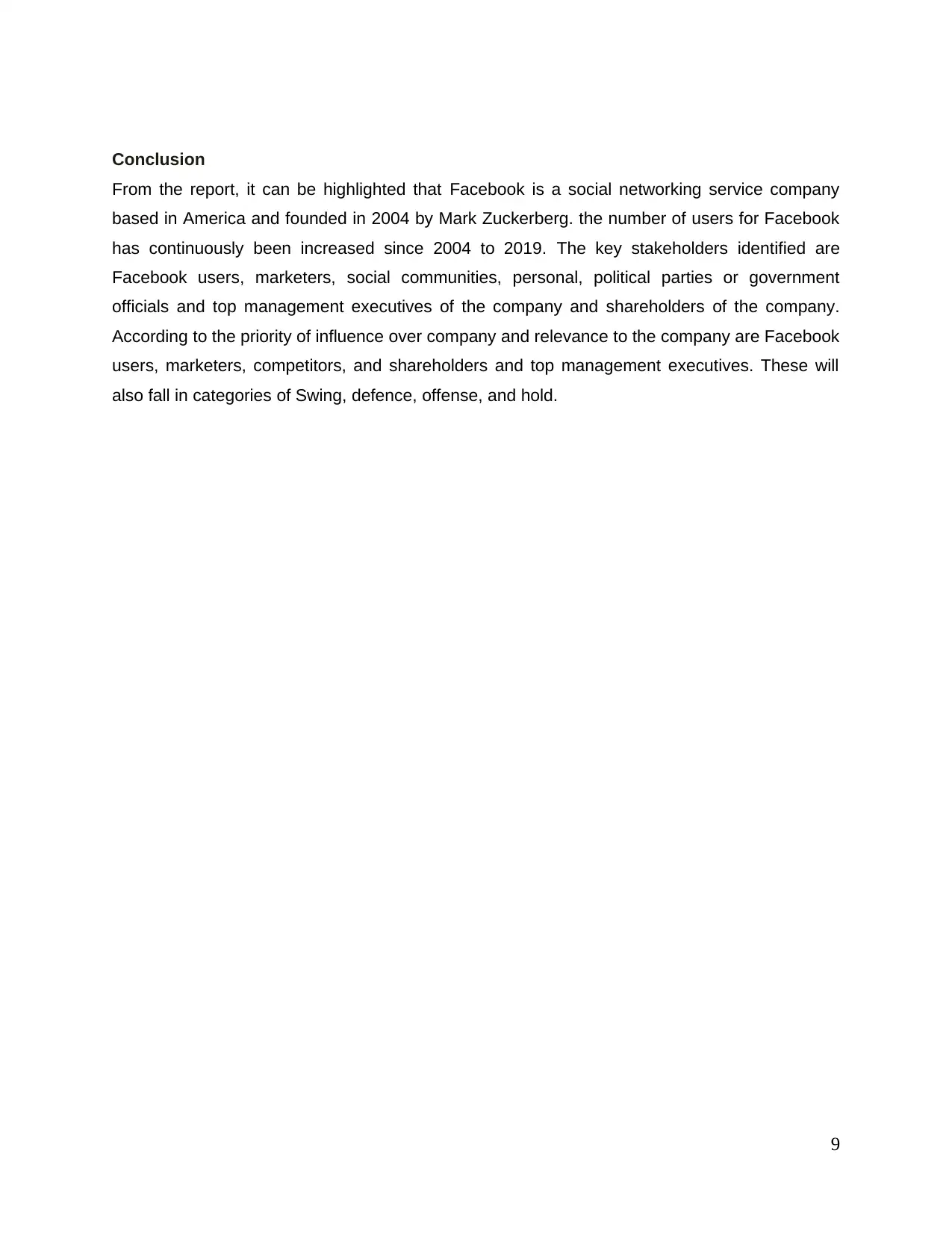
Conclusion
From the report, it can be highlighted that Facebook is a social networking service company
based in America and founded in 2004 by Mark Zuckerberg. the number of users for Facebook
has continuously been increased since 2004 to 2019. The key stakeholders identified are
Facebook users, marketers, social communities, personal, political parties or government
officials and top management executives of the company and shareholders of the company.
According to the priority of influence over company and relevance to the company are Facebook
users, marketers, competitors, and shareholders and top management executives. These will
also fall in categories of Swing, defence, offense, and hold.
9
From the report, it can be highlighted that Facebook is a social networking service company
based in America and founded in 2004 by Mark Zuckerberg. the number of users for Facebook
has continuously been increased since 2004 to 2019. The key stakeholders identified are
Facebook users, marketers, social communities, personal, political parties or government
officials and top management executives of the company and shareholders of the company.
According to the priority of influence over company and relevance to the company are Facebook
users, marketers, competitors, and shareholders and top management executives. These will
also fall in categories of Swing, defence, offense, and hold.
9
Paraphrase This Document
Need a fresh take? Get an instant paraphrase of this document with our AI Paraphraser
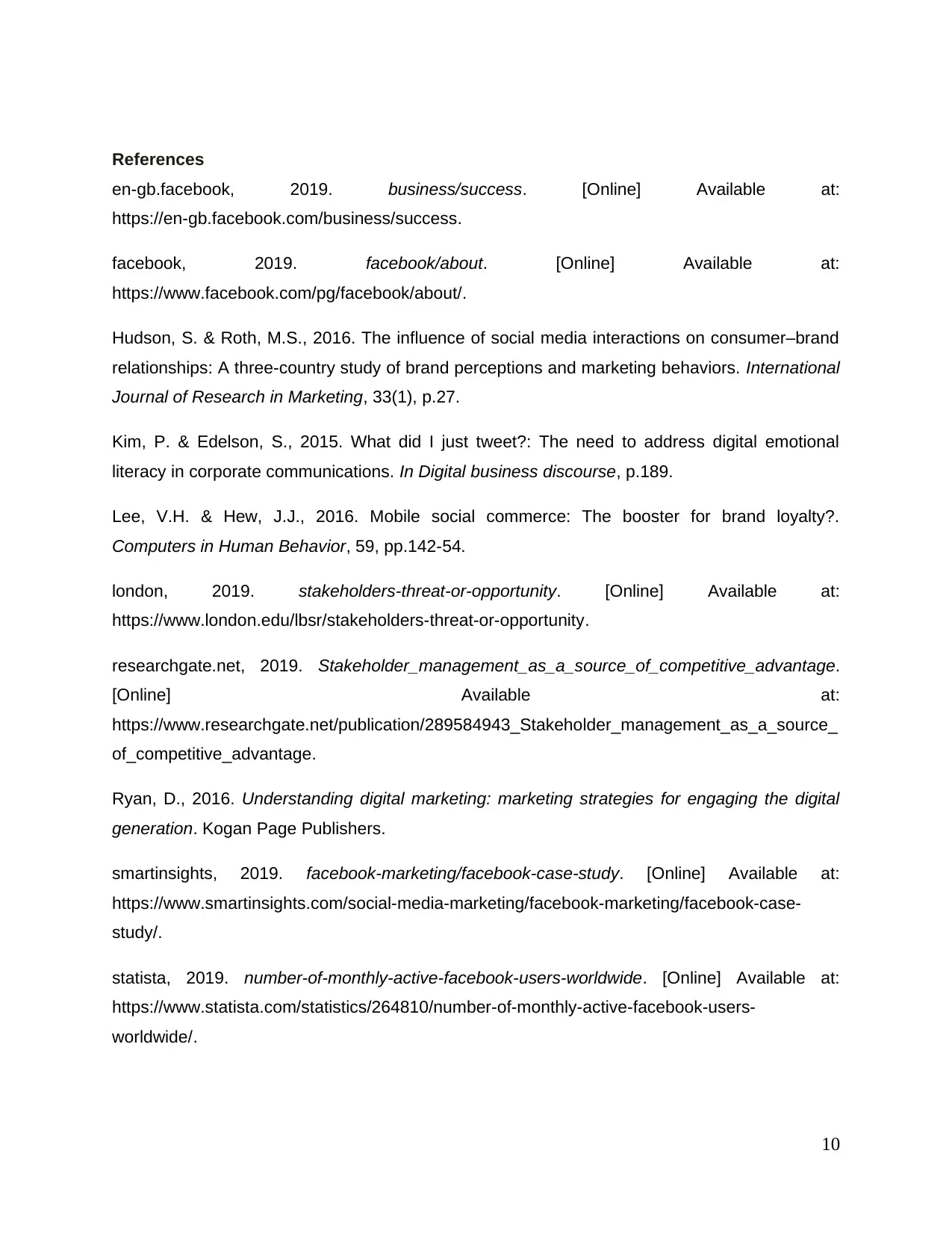
References
en-gb.facebook, 2019. business/success. [Online] Available at:
https://en-gb.facebook.com/business/success.
facebook, 2019. facebook/about. [Online] Available at:
https://www.facebook.com/pg/facebook/about/.
Hudson, S. & Roth, M.S., 2016. The influence of social media interactions on consumer–brand
relationships: A three-country study of brand perceptions and marketing behaviors. International
Journal of Research in Marketing, 33(1), p.27.
Kim, P. & Edelson, S., 2015. What did I just tweet?: The need to address digital emotional
literacy in corporate communications. In Digital business discourse, p.189.
Lee, V.H. & Hew, J.J., 2016. Mobile social commerce: The booster for brand loyalty?.
Computers in Human Behavior, 59, pp.142-54.
london, 2019. stakeholders-threat-or-opportunity. [Online] Available at:
https://www.london.edu/lbsr/stakeholders-threat-or-opportunity.
researchgate.net, 2019. Stakeholder_management_as_a_source_of_competitive_advantage.
[Online] Available at:
https://www.researchgate.net/publication/289584943_Stakeholder_management_as_a_source_
of_competitive_advantage.
Ryan, D., 2016. Understanding digital marketing: marketing strategies for engaging the digital
generation. Kogan Page Publishers.
smartinsights, 2019. facebook-marketing/facebook-case-study. [Online] Available at:
https://www.smartinsights.com/social-media-marketing/facebook-marketing/facebook-case-
study/.
statista, 2019. number-of-monthly-active-facebook-users-worldwide. [Online] Available at:
https://www.statista.com/statistics/264810/number-of-monthly-active-facebook-users-
worldwide/.
10
en-gb.facebook, 2019. business/success. [Online] Available at:
https://en-gb.facebook.com/business/success.
facebook, 2019. facebook/about. [Online] Available at:
https://www.facebook.com/pg/facebook/about/.
Hudson, S. & Roth, M.S., 2016. The influence of social media interactions on consumer–brand
relationships: A three-country study of brand perceptions and marketing behaviors. International
Journal of Research in Marketing, 33(1), p.27.
Kim, P. & Edelson, S., 2015. What did I just tweet?: The need to address digital emotional
literacy in corporate communications. In Digital business discourse, p.189.
Lee, V.H. & Hew, J.J., 2016. Mobile social commerce: The booster for brand loyalty?.
Computers in Human Behavior, 59, pp.142-54.
london, 2019. stakeholders-threat-or-opportunity. [Online] Available at:
https://www.london.edu/lbsr/stakeholders-threat-or-opportunity.
researchgate.net, 2019. Stakeholder_management_as_a_source_of_competitive_advantage.
[Online] Available at:
https://www.researchgate.net/publication/289584943_Stakeholder_management_as_a_source_
of_competitive_advantage.
Ryan, D., 2016. Understanding digital marketing: marketing strategies for engaging the digital
generation. Kogan Page Publishers.
smartinsights, 2019. facebook-marketing/facebook-case-study. [Online] Available at:
https://www.smartinsights.com/social-media-marketing/facebook-marketing/facebook-case-
study/.
statista, 2019. number-of-monthly-active-facebook-users-worldwide. [Online] Available at:
https://www.statista.com/statistics/264810/number-of-monthly-active-facebook-users-
worldwide/.
10
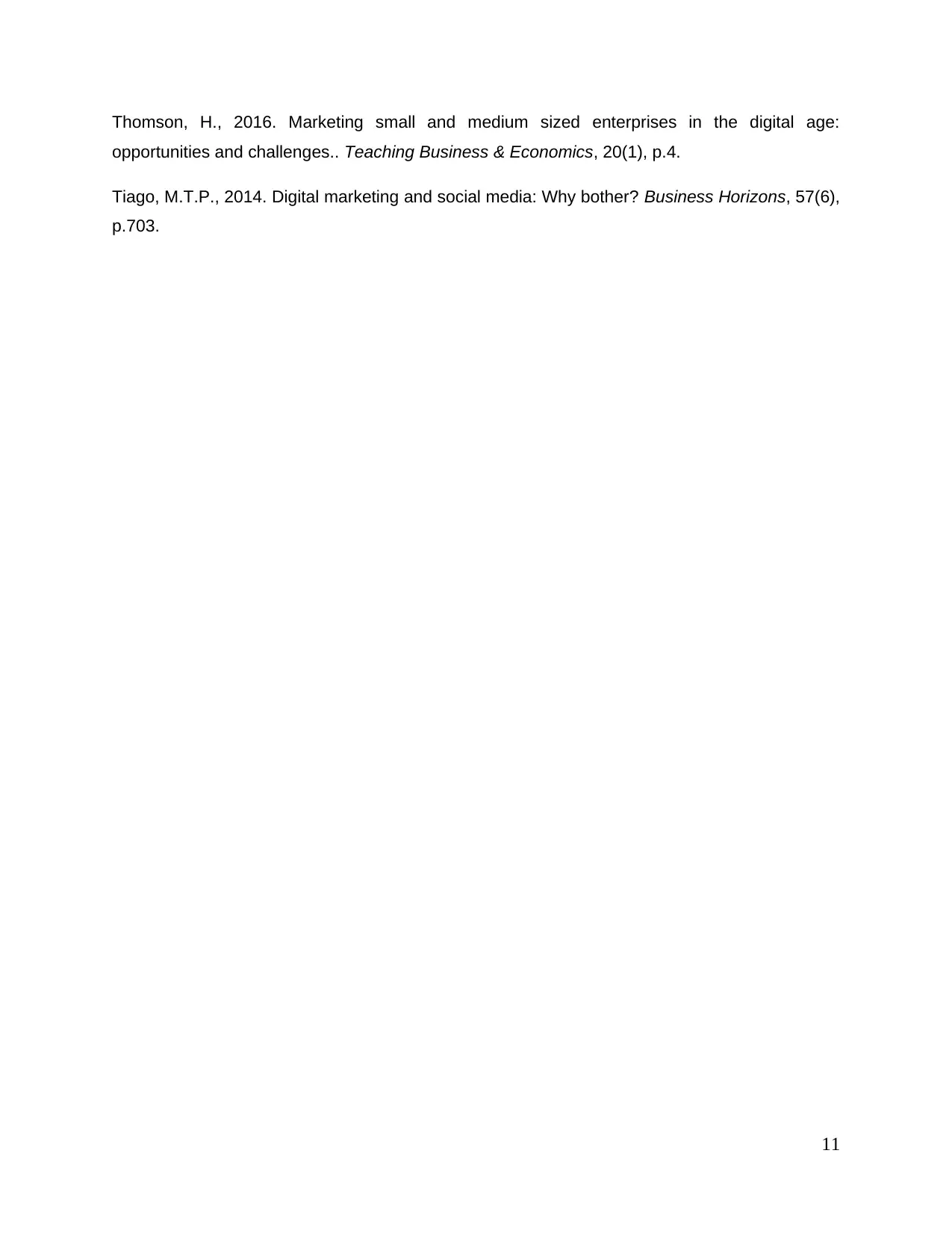
Thomson, H., 2016. Marketing small and medium sized enterprises in the digital age:
opportunities and challenges.. Teaching Business & Economics, 20(1), p.4.
Tiago, M.T.P., 2014. Digital marketing and social media: Why bother? Business Horizons, 57(6),
p.703.
11
opportunities and challenges.. Teaching Business & Economics, 20(1), p.4.
Tiago, M.T.P., 2014. Digital marketing and social media: Why bother? Business Horizons, 57(6),
p.703.
11
⊘ This is a preview!⊘
Do you want full access?
Subscribe today to unlock all pages.

Trusted by 1+ million students worldwide
1 out of 12
Related Documents
Your All-in-One AI-Powered Toolkit for Academic Success.
+13062052269
info@desklib.com
Available 24*7 on WhatsApp / Email
![[object Object]](/_next/static/media/star-bottom.7253800d.svg)
Unlock your academic potential
Copyright © 2020–2025 A2Z Services. All Rights Reserved. Developed and managed by ZUCOL.





